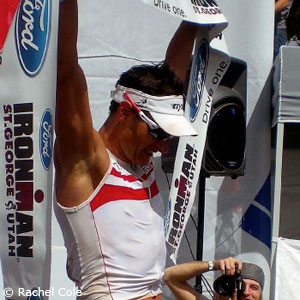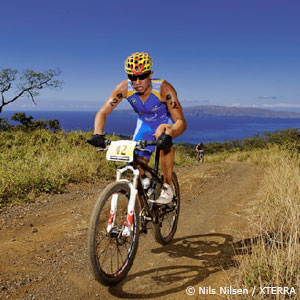A conversation with Michael Weiss
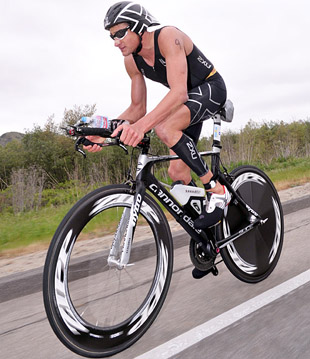
After the disappointment of failing to make the Austrian mountain bike team for the 2008 Olympics, Michael Weiss took the advice of many friends and turned his talents to triathlon. Within the year, he had a second place finish to Andreas Raelert at the Monaco Ironman 70.3, largely on the strength of his biking skills on that demanding hilly course. Since then, he has been honing his swim and his run well enough to take second, third and third at the XTERRA World Championship, have a breakthrough win at Ironman St. George and take 13th at Ironman Hawaii with the second fastest bike split.
This conversation with Weiss and his fiancée Rachel Cole came the day before his third place finish at Oceanside in which he set fastest bike (2:11:54) and third fastest run (1:13:15) which left him just 22 seconds behind world class competitor and the day’s runner-up, Rasmus Henning of Denmark.
Slowtwitch: You grew up in a beautiful part of Austria. But it looks like you have settled in Colorado.
Michael Weiss: SRM [Schoberer Rad Messtechnik – the cycling power meter company] has been my sponsor since I was a professional mountain biker and since my transition to triathlon. SRM brought me to Colorado Springs six years ago [where they have a key North American service center]. I just went there for mountain biking training camps. And I always liked Colorado and the U.S. and I dreamed to live there.
ST: It looks like you have found the right woman to share that life.
Michael: Yes I have. We met in Kona two years ago. Rachel Cole is from Kennebunkport, Maine and we will get married there in August.
ST: Will President George H.W. Bush and his family be there? It's their summer home.
Rachel Cole: LAUGHS.
ST:: Barbara Bush can be a flower girl.
Michael: Your dad knows them right?
Rachel: Yes, But …
ST: Not invited, I guess.
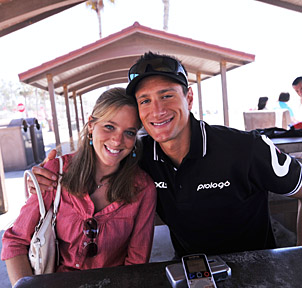
Michael: So we moved to Colorado Springs in January 2010. She used to work in veterinary medicine [as a Diagnostic Practice Consultant for IDEXX Laboratories]. I introduced her to the people in the office and she works for SRM now [in SRM Sales and Service and Triathlon Marketing]. Now they are doing a lot more in triathlon and she had an important assignment last year at Kona. SRM did live telemetry online of 10 riders at Kona throughout the race and she was in charge of that whole project.
ST: That was high tech and high stress?
Michael: Yes. They had some problems with the server — so many people phoned in, the system became overloaded. How many people connected to the SRM during the Tour de France?
Rachel: We had 10,000 visitors on our Tour de France website, so we thought 10,000 would be OK for Kona. We had to add another server halfway through the bike at Kona and we got back up and going. We were shocked about how many people were going online. Our server capacity was absolutely maxed out.
ST: How many visitors were there actually?
Rachel: Way more that we anticipated. We got maxed out at 10,000, so there was no way to know for sure how many there could have been.
ST: How many pro triathletes offered telemetry on the SRM site?
Rachel: We had 10 pro riders. Michael, Dirk Bockel…
Michael: … Faris Al Sultan – and a lot of good people
Rachel: You could follow their progress on the course with GPS, heart rate, speed, cadence and power output. It was pretty cool.
Michael: They should have all the athletes throughout the race. It would be so much more exciting.
Rachel: I would like to see age groupers, too. My mom was doing the race and I would have loved to have been able to see where she was on the bike course. Other than just knowing she’s out there, somewhere.
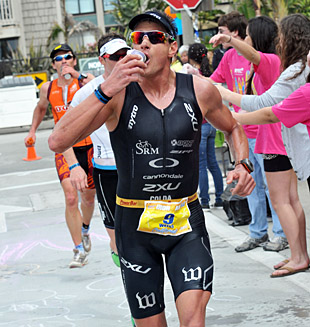
ST: Colorado Springs has great trails and roads.
Michael: That is why I moved there. It’s great for mountain biking,
ST: You have to be adaptable to the thinner air at higher elevations – the Rockies are much higher than Europe’ mountains?
Michael: Right. We live at six thousand five hundred feet and I ride up to 10,000 in training. I got used to it and it helps me, especially the swim. When I go to sea level, I can breathe every 5th stroke. The altitude training is hard — I train at the Olympic Training Center every day with members of the US national team. Matt Chrabot and Sarah Haskins and those guys.
ST: They welcome you because you do not compete against them in short course triathlon and mountain biking, I presume?
Michael: True. I don’t do Olympic distance.
ST: Where do you finish at XTERRA?
Michael: Second in 2008, third in 2009 and 2010 at Maui.
ST: XTERRA might be your favorite type of racing?
Michael: It’s like a family, a community. [XTERRA executives] Dave Nicholas and Janet Clark put together great races and they have a lot of heart. I would love to do more XTERRAs but it’s just not my sponsors’ highest priority.
ST: What pavement races do you like?
Michael: I enjoy doing halves and I will do Ironman St. George again.
ST: When did you know you had arrived with the top rank of long course triathletes?
Michael: When I won St. George last year. [Weiss finished in 8:40:08, 12:46 ahead of runner-up Ben Hoffman. Weiss’s 4:43:01 bike was 10 minutes faster than his closest pursuers and his race-best 2:58:03 run was 6:50 better than runner-up Ben Hoffman]. That was my breakthrough. I like hard bike courses. Starting out in triathlon, I finished second twice at Monaco 70.3 – behind Andreas Raelert in 2008 and behind Axel Zeebroek in 2009. But St George was my biggest breakthrough.
ST: What qualities must you have to continue to improve?
Michael: I know the most important thing for me is patience. You cannot force your muscles to adapt immediately to running. You have to wait and just keep training hard — same on the swim. So that is what I have done. I just got better and better on the run and the swim. And I can keep my high level on the bike. That is the secret behind my training.
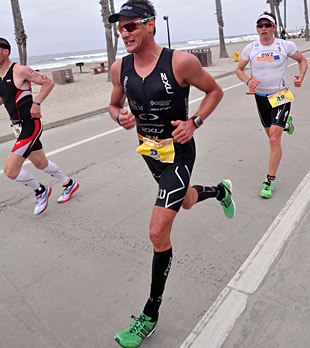
ST: Why did you leave mountain biking?
Michael: People told me, ‘You should try triathlon’ two three years before I quit mountain biking.
ST: Why?
Michael: Because I always did very well in small run competitions — like winter cross runs. I was always the runner. I used to run as a mountain biker. I used to run in winter two or three times a week. And swimming, with my arms [he has a big wingspan] — it’s not that bad. I had to swim in high school. I hated it but that helps me now.
ST: Where did you grow up?
Michael: Gumpoldskirchen Austria, about 20 kilometers south of Vienna. It’s very famous for wine. It’s a big wine area almost like Napa. Napa is bigger and there is more red wine. But we have a lot of red wine, too.
ST: You made the Olympics in mountain biking. What led you away?
Michael: I was too tall and too big for mountain biking. I am 6-3 and 170 to 175 pounds. Bart Brentjens, who won the first cross country mountain bike gold at the 1996 Olympics in Atlanta, is the only really tall mountain biker to win big. In 2000 Miguel Martinez, who was quite short and light, won Olympic gold. He was great on hills. There were some tall mountain bike guys who were good but they changed to the road. And I was just too heavy, you know? I had good races on a flat courses or rolling courses but as soon as things got steep on mountain bike courses …
ST: What was the culmination of your mountain bike career?
Michael: I made the Austrian mountain bike team at the 21004 Olympics and competed in Athens. The next few years, I made several top 10s at major races. But I didn’t qualify for the 2008 Olympics in Beijing. Every nation has different Olympic qualification rules, and the Austrian qualifying process made it difficult. First of all, you have to qualify in the same year as the Olympics, which makes it difficult to taper and have a good performance for the big race. In the US, it is more common to have trials to make the team. But Austria makes you compete everywhere, all the time, chasing points.
ST: You got worn down?
Michael: Yeah. I didn’t make Beijing Olympics and I was kind of burned out.
ST: So you were a bit like Andreas Raelert –– looking for something else to do after missing the Olympic team? He went from Olympic distance to Ironman, You went from mountain biking to triathlon.
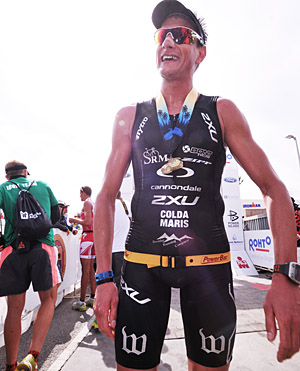
Michael: At first I thought I should go to road cycling. But I was not happy in that community. I tried it but I didn’t like it. Then I tried my first triathlon – a small XTERRA in Austria. I did four triathlons right in a row after the Beijing Olympics. There was so much in me that I couldn’t express in mountain biking. I did well and then I felt like newborn. I did all the first triathlons relying on my bike and I thought it would take a couple of months to really get into triathlon.
ST: Why?
Michael: To change the routine is the first thing. A cyclist gets up at 10 and then you ride 5 or 6 hours and you are done. Triathlon, it’s a lifestyle. You have to live for it. You get up early and balance the three disciplines. That is what I do now and my family and especially my fiancée — soon to be wife,
ST: What was key to start making a living in a new sport?
Michael: I didn’t have an agent for a long time. Now Wattie [Sean Watkins] helps me out. He has good connections and we have a super good personal relationship. The harmony and chemistry between the both of us is excellent.
ST: How did you run into him?
Michael: I met Wattie and [his girlfriend, top 70.3 competitor] Heather Jackson the first time two years ago in Monaco. Now I am 30, I need an agent just to get all the things together.
ST: That was definitely true for Luc van Lierde, who got so overwhelmed with the stress of arranging all his own equipment and making arrangements at the last minute, he pulled out of 2000 Ironman Hawaii two days before the race. And he was the defending champion.
Michael: Two times Ironman World Champion!
ST: So you are not crazy to pay a manager.
Michael: Just ask her… [gestures to Rachel]
ST: What were your significant races – in addition to St. George — in 2010?
Michael: I finished 13th at Kona with second fastest bike split [4:25:21, 2 minutes and 3 seconds behind Chris Lieto but six minutes ahead of McCormack, Raelert Vanhoenacker and Tissink] This year it was crazy how fast so many guys ran [7 men were under 2:50, 23 under 3 hours] I ran a 3:00:34 marathon — but it was better than Chris Lieto [3:06:00] and Maik Twelsiek [3:04:38.] So I was encouraged.
ST: You ran a balanced race.
Michael: I did my run coming after a complete time trial because I never ride in a group in my life. Always. So I came 6th into T2 and then I did my pace on the run.
ST: How much time did you lose in the swim?
Michael: I swam 57:30 and gave away 5-6 minutes to the leaders. I’m getting better. .
ST: How did your Kona finish make you feel?
Michael: I felt great and it made me confident for the future. I think eventually I will be able to run 2:55 there, and ultimately 2:50. Good enough to get top 3. Again, I must have patience so in the future I can show the hard work paid off.
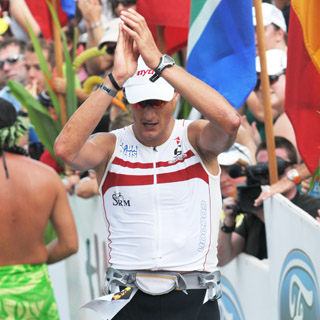
ST: How has working with SRM helped make a great cyclist better? What SRM numbers are most important to you?
Michael: Most of the people train with an SRM but they don’t use it in a race. But I train to test myself with a power meter and I can really tell in training how I can race. Then on race day the SRM helps me with pacing. Maybe it is different for other pros because they ride in the pack. They ride more with the dynamic of the pack at Kona. But I will always race it as a time trial and that is why the SRM is useful to me in races. And that is why I try to work a lot on specific pacing. Which is over the comfort zone, mostly.
ST: How does that feel?
Michael: No, it’s not fun to ride that pace. Always push, push, push.
ST: What is different training for triathlons on the bike than in your mountain bike days?
Michael: I still do high intensity programs indoors on the trainer, like I used to do as a mountain biker. But I cut the volume of intensity sessions in half. For example, I had a 5000 meter swim in the morning and then I go to the bike. But if I try to do what I used to do, it’s impossible. Because you are limited from your metabolism and from your carbohydrate consumption. You can’t go three hours every day at tempo along with swim and run training on top of that. You have to be very sensitive for your intensity and your volume.
ST: So what training principles guide you?
Michael: For me it is always better to be five percent less than maximum. I am a professor in that way. I always say it is better too little than too much. Especially at high altitude.
ST: That is a very fine line to draw?
Michael: It is very close between optimum and too much. So I do that short intensity work at real high intensity. When I talk to the ITU guys I train with every day, I see some of them have the same strategy regarding their old single sport accomplishments. I know Andy Potts trains different on the swim than the others because he has such huge background. Since I rode my mountain bike since the age of 12, I have a huge base. I just can push harder in training than others can do in my original sport. But I don't need to do as much of it. Again, it is all about pacing and a lot of quality.
ST: What does an SRM printout mean when you see it?
Michael: It tells me within 15 minutes where I am in fitness at that time.
ST: Can you give me an example what might you do with that knowledge?
Michael: I might say ‘Well I’m far away from my top shape.’ Or ‘I am almost there.’ So then I don’t push so hard at the time.
ST: If you are far from top shape, how do you approach your training?
Michael: I have the patience to say I need those four to eight weeks more. But usually I don’t have to take that long to get back to peak fitness.
ST: I see you put your training SRM results on the bike on Facebook. Most guys keep that information secret.
Michael: I don’t hide it. I don’t care if people know. Same for the races.
ST: What was your highest watts last year in all distances?
Michael: Actually SRM analyzes it on the website in English and in German. I had 335 watts last year at Oceanside on average. And I missed the fastest bike by 5 seconds to Michael Raelert.
ST: Do you pay attention to your minimum and maximum power output numbers?
Michael: The minimum is not crucial. And a single point maximum is not relevant. It is more important to find my power over a certain period of time. In 4 minutes on a steep climb, I can go over 400 watts power. I found a valuable thing coming into this year’s race. When I looked at my SRM data from last year at Oceanside, I found that over the first hour I averaged over 370 watts. Way too much. Then I broke down in the second half to 310. This year I know it will be better to start out at 335 watts. Probably Bjorn Andersson will be faster. People like a strong guy on the bike like that but then he dies on the run. Now I have the confidence that starting at 335 watts brings me in the top contenders.
ST: And you could negative split your watts on the bike this year?
Michael: That is my goal.
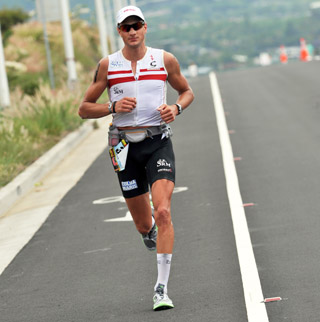
ST: Will your time improve?
Michael: My bike is improving for several reasons. Now I am on Zipp wheels and I have a better position on the bike than last year. So that gives me so much. It is not like I am in the dark like some other riders where I don’t know where I stand or what is right or wrong with my bike. I know what I should be doing and I stick to my plan.
ST: Some say the SRM can’t help you on race day – and why carry the weight?
Michael: The weight doesn’t matter. No! Maybe one second. And you get so much benefit of the gadget.
ST: How far can you go in this Ironman world?
Michael: More important than looking so far ahead is to it is to keep working hard every day.
ST: But not too hard that you blow up, get injured or sick?
Michael: Stick to the plan. Listen to the body. My triathlon coach is Mario Huys of Belgium – he is very good and he has advised Yvonne Van Vlerken when she held the women’s Ironman record time for a while.
ST: I read he did some work with Luc Van Lierde and Kate Allen.
Michael: My coach is very good. But he says I must listen to my body. No coach can see into the body. Sometimes the coaches say you must do this or that workout. And some days I say ‘No, I cannot push that hard today. I have to take it easy.’ I am not wimping out. I try to be smart and patient. I give myself another three years to improve and to become a better runner. And I have already improved a lot.
ST: What is the biggest difference in your body after three years of triathlon?
Michael: My muscles look more like a runner now. Before I was too big in the upper body. This year a realistic goal in Kona is a top 10 after 13th last year. But in Kona everything has to be on that day. Everything. There are no excuses and you have to show where you are and what you are made of. I think I can be up there if it is my day and I am a lucky guy.
ST: How long can your professional career go on?
Michael: I will keep on trying and I hope to do the sport the next 5 to 10 years. I want to do the sport as long as possible and respect my body. I don’t want to mess up my body.
ST: Is there anything standing in the way of improving your run after so many years of mountain biking?
Michael: No. I can say I am a good runner and I have good speed. I can run a 10k in almost 30 minutes. I did a running race in downtown Colorado Springs on St Paddy’s Day. It was a real 5k – not a short course – and it's at altitude. And I ran 15:20. That was out of training, running 5 hours a week. I have raw speed and, without being cocky, I can say I am getting there.
ST: Can you win now?
Michael: If you look at all the guys with so much experience in triathlon like Macca and Andreas Raelert and Rasmus Henning, it would be unrealistic that a guy like me who has been doing triathlon for only a few years comes in and beats them. They have their time. And I will have my time, eventually. That is why I always compete against the best. I wish I could compete against Lance Armstrong in cycling and Macca all at their peak. I don’t want to hide. I want to go there and compete with them.
ST: Are you afraid you will never reach that point?
Michael: The good thing is I was still living mentally as a mountain biker where the peak is in the mid 20s to early 30s. And all of a sudden in triathlon I have a decade more of my prime to become better.
ST: Do you have the temperament to wait this long to get to the top?
Michael: I am a perfectionist and I have no ego about past performances. I always want to be better. It is not like ‘OK I won this St. George and now I will put my feet up and rest on that honor.’
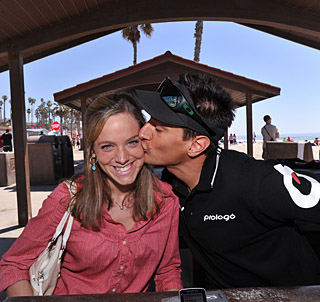
ST: How have you transitioned from mountain bike to triathlon sponsors?
Michael: My very first sponsor in triathlon is an Austrian company, Colda Maris. They make a nose spray of sea salt which helps cure cold symptoms. Cannondale supports me and 2XU is a great sponsor. But SRM is the base. They have helped me out for 8 years now. They are happy that I am willing to share all my training and racing data. Most pros don’t like to show their files. But I don’t care. SRM has done a lot for me. They give me many different kinds of support. They give me my home base in Colorado and also they have job for Rachel my fiancée, so she can travel with me. Of course they only hire her because she is talented.
ST: Where did you meet?
Michael: We met in Lava Java in Kona.
ST: What did you talk about?
Rachel: He met my mom first.
Michael: First you have to tackle the mom, check out the mom. No, I’m kidding. They were sitting in Lava Java. It was crowded, two days before the race. I had my carrot cake and my latte and asked if I could sit with them. I joined them and anyway I make moves to see her at the after race party.
ST: You were quite polite at first?
Rachel: He was extremely polite.
Michael: Then we met again in Boston three days after Kona.
Rachel: I was living in Salem, Massachusetts, near Boston.
Michael: I convinced her to come back one week later to Maui, where I was racing XTERRA.
ST: That was…
Michael: A great move!
Rachel: Yeah.
ST: Of all the places in the world to invite her to a race, that was probably the best!
Michael: Right.
Rachel: It was very relaxed and friendly.
Michael: After the race, I went home three weeks to Austria. And since then, we live together in the USA. Now I am getting everything together — visa, green card and all the rest. We have a lot of paperwork right now, but we are getting there.
ST: When he started talking to our mom, what was your impression?
Rachel: SMILES. Oh, I felt a connection to him immediately. I don’t know exactly why. But he was such a warm, polite person.


